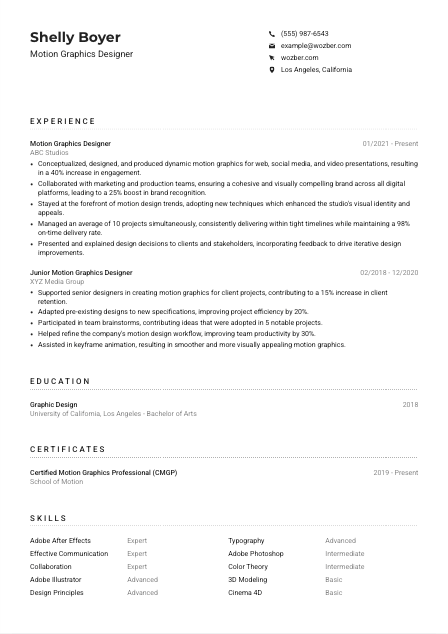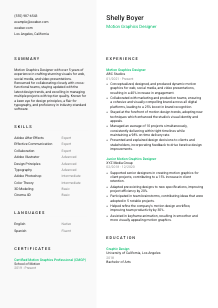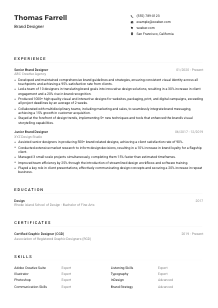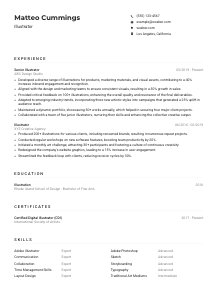Motion Graphics Designer Resume Example
Animating visuals, but your resume feels stationary? Dive into this Motion Graphics Designer resume example, crafted with Wozber free resume builder. Learn how effortlessly you can sync your dynamic design skills with job specifics, turning your career trajectory into a beautifully animated journey!

How to write a Motion Graphics Designer Resume?
Hello, creative visionary! In the realm of Motion Graphics Design, standing out is more than an art form; it's essential for career advancement. Your resume isn't just a document; it's a testament to your creativity, technical proficiency, and dedication to your craft.
With the power of Wozber's free resume builder at your disposal, let's navigate the intricate dance of molding your resume into a magnet for opportunities, perfectly aligned with the Motion Graphics Designer role you're after. Let's transform your career trajectory into a visual masterpiece, shall we?
Personal Details
The opening act of your resume sets the stage for your professional narrative. Let's decode how to fine-tune this section to resonate with the role of a Motion Graphics Designer, making it not just accurate but perfectly harmonized with the job's nuances.
1. Name as Your Brand
Your name is the marquee of your personal brand. Employ a clear, readable font that captures attention, subtly larger than the rest of your resume to ensure it's the first thing to catch the hiring manager's eye.
2. Job Title Alignment
Mirroring the job title from the job description right below your name can be a strategic move. It instantly clarifies your target position, which in this case is "Motion Graphics Designer," making it crystal clear to the hiring manager that your application is not by chance but by choice.
3. Essential Contact Info
List your most accessible contact number and a professional email address using a straightforward format like firstname.lastname@email.com. This basic yet crucial information ensures the hiring manager can easily reach out to you.
4. Location Matters
Given the job's requirement for someone located in Los Angeles, California, stating your city and state upfront meets one of the fundamental criteria head-on. It reassures hiring managers that you're already part of the local talent pool.
5. Online Presence
If you have a LinkedIn profile or a professional portfolio website showcasing your Motion Graphics projects, include it. Make sure it's polished and mirrors the strengths and experiences highlighted in your resume. For Motion Graphics Designers, having an online portfolio can significantly amplify your application's impact.
Takeaway
Think of the Personal Details section as setting the tone for your professional story. It's brief yet impactful, and when perfectly aligned with your targeted role, it paves the way for a standout first impression.





Experience
Here lies the beating heart of your resume. Your professional experience is your battleground to showcase your creativity, impact, and alignment with the pivotal aspects of the Motion Graphics Designer role.
- Conceptualized, designed, and produced dynamic motion graphics for web, social media, and video presentations, resulting in a 40% increase in engagement.
- Collaborated with marketing and production teams, ensuring a cohesive and visually compelling brand across all digital platforms, leading to a 25% boost in brand recognition.
- Stayed at the forefront of motion design trends, adopting new techniques which enhanced the studio's visual identity and appeals.
- Managed an average of 10 projects simultaneously, consistently delivering within tight timelines while maintaining a 98% on‑time delivery rate.
- Presented and explained design decisions to clients and stakeholders, incorporating feedback to drive iterative design improvements.
- Supported senior designers in creating motion graphics for client projects, contributing to a 15% increase in client retention.
- Adapted pre‑existing designs to new specifications, improving project efficiency by 20%.
- Participated in team brainstorms, contributing ideas that were adopted in 5 notable projects.
- Helped refine the company's motion design workflow, improving team productivity by 30%.
- Assisted in keyframe animation, resulting in smoother and more visually appealing motion graphics.
1. Dissecting Job Requirements
Begin by meticulously parsing the job description, highlighting demands such as experience with Adobe After Effects, collaboration with cross-functional teams, and the ability to manage multiple projects. This understanding is your north star in curating your experience narrative.
2. Roles and Companies Framework
Organize your experience chronologically, starting with your current or most recent position. For each role, include the job title, company name, and the dates of your tenure to construct a clear professional timeline.
3. Crafting Targeted Accomplishments
Delve into your achievements in each position, directly linking them to the requirements of the Motion Graphics Designer role. Whether it was an increase in engagement due to your designs or successful collaboration leading to brand consistency, each point should echo the job's demands.
4. Quantifying Success
Whenever possible, bolster your accomplishments with tangible metrics. For instance, "resulting in a 40% increase in engagement" offers a concrete measure of your impact. Percentages, timelines, and project counts are potent ways to quantify your contributions.
5. Relevance is Key
Maintain focus on experiences most pertinent to motion graphics design. Extraneous details might dilute the potency of your application. Prioritize content that showcases your design skillset, understanding of design principles, and your proficiency with crucial software.
Takeaway
Use the experience section to narrate your professional journey, emphasizing your readiness and fit for the Motion Graphics Designer role. This section isn't just a list but a storyboard of your career, capturing your growth, impact, and how you're the perfect candidate for the role.
Education
Your education forms the foundation of your skill set. While it may seem straightforward, presenting this section thoughtfully can underscore your suitability for the Motion Graphics Designer role.
1. Identifying Key Requirements
The job requires a "Bachelor's degree in Graphic Design, Motion Design, or a related field." Ensure this requirement is met head-on in your resume, clearly listing your relevant educational background.
2. Educational Structure
Present your education in a clear, structured format: Degree, field of study, institution name, and graduation date. This structured approach ensures the hiring manager can quickly confirm your educational qualifications.
3. Degree Specifics
If your degree aligns with the job's demands, as in having a Bachelor of Arts in Graphic Design, make sure it's prominently listed. This directly correlates your academic credentials with the role's requirements.
4. Coursework and Projects
For roles tightly integrated with technical skills and creativity like a Motion Graphics Designer, listing relevant courses or projects can further validate your capabilities. While not always necessary, it can be especially beneficial early in your career.
5. Extra Achievements
Include any honors, club memberships, or significant projects related to graphic design or motion graphics if they bolster your application. However, align this with the seniority level of the position to maintain relevancy.
Takeaway
Your education section reinforces your foundational expertise, aligning it with the Motion Graphics Designer role's demands. It's more than just degrees; it's proof of your dedication and the backbone of your skill set.
Certificates
In the ever-evolving field of graphic design and motion graphics, certifications serve as badges of continuous learning and expertise. Let's craft a certifications section that reflects your commitment to staying ahead in your field.
1. Job Requirements Analysis
Initially, cross-reference the job description to ensure any required certifications are prominently displayed. In the absence of explicit certification needs for the Motion Graphics Designer position, leverage this section to showcase your initiative and commitment to professional growth.
2. Strategic Certificate Selection
Select certifications that showcase your expertise in key areas such as Adobe After Effects or other relevant software, as well as any that demonstrate a broader understanding of design principles. This focused approach ensures the hiring manager sees the most relevant qualifications at a glance.
3. Date Transparency
For certifications, especially those in technology that might evolve rapidly, including the date of achievement can be insightful. It demonstrates your commitment to keeping your skills updated in the fast-paced design world.
4. Continuous Learning
In a field like Motion Graphics Design, the learning never stops. Regularly update your certifications and seek new ones that align with the trajectory of your career and the evolution of the industry.
Takeaway
Use certifications to illustrate your perpetual growth and specialization in areas critical to the Motion Graphics Designer role. They're not just accolades but reflections of your dedication to excellence and continual improvement in your craft.
Skills
The Skills section is your opportunity to concisely showcase your professional arsenal. For a Motion Graphics Designer, this is where you highlight your mastery over the tools of the trade and your soft skills prowess.
1. Unpacking the Job Description
Dig into the job description to extract both the explicitly stated and the implied skills needed for the role. Skills like proficiency in Adobe After Effects, strong design principles, and effective communication are likely candidates.
2. Match and List
Closely align your own skill set with those listed in the job description, focusing on hard skills like software proficiency and design techniques, as well as soft skills like collaboration and communication.
3. Organization is Key
Resist listing every skill you possess. Prioritize and organize your skills section to highlight your strongest and most relevant talents first, making it easy for hiring managers to assess your fit for the role at a glance.
Takeaway
Approach the skills section as a curated showcase of your capabilities. It's an invitation to the hiring manager to consider you not just as a competent candidate, but as an invaluable future asset to their team.
Languages
In the diverse field of graphic design, being multilingual can set you apart. Let's maximize the languages section to demonstrate your communication skills and global mindset.
1. Job Language Requirements
Check if the job specifies necessary language skills. For our Motion Graphics position, "English language competency is a must." Ensure your resume reflects this prerequisite prominently.
2. Emphasize Required Languages
List English at the top of your languages section, marking it as 'Native' or 'Fluent' to directly match the job's needs. This immediate alignment ensures no doubts about your ability to communicate effectively in the workplace.
3. Showcase Additional Languages
Including other languages you're proficient in can showcase your versatility and potential to engage with diverse teams or clients, adding another layer of appeal to your application.
4. Honesty in Proficiency
Clearly specifying your proficiency level for each language presents a transparent and credible picture of your communication skills, fostering trust right from the start.
5. Understanding the Role's Scope
For roles that touch global markets or involve collaborative projects across different regions, your multilingual abilities can significantly enhance your attractiveness as a candidate.
Takeaway
View your language skills as bridges to new opportunities, facilitating smoother communication and deeper connections in an increasingly globalized world. They're not just competencies; they're tools that enable you to navigate diverse cultural landscapes.
Summary
The summary section is your chance to shine, to distill your essence into a few powerful sentences. It's where you convince the hiring manager that not only are you a viable candidate, but the ideal Motion Graphics Designer for the job.
1. Capturing the Job's Essence
Begin by absorbing the fundamental requirements of the job. Understanding what truly matters for the position allows you to craft a summary that resonates with the reader.
2. Start with a Bang
Lead with a strong opening statement that encapsulates your profession, years of experience, and a highlight or two of your professional journey, immediately asserting your suitability for the role.
3. Address Key Job Requirements
Weave in a few of your paramount skills and accomplishments, ensuring they reflect the core needs of the Motion Graphics Designer role. This is your chance to show how your unique contributions can benefit the potential employer.
4. Conciseness is Power
Your summary should be succinct, aiming for 3-5 impactful lines. It's your elevator pitch - powerful, precise, and leaving the reader eager to learn more about you.
Takeaway
Your summary isn't just an introduction; it's a compelling teaser of your professional narrative. It underscores your alignment with the role of a Motion Graphics Designer and sparks an interest that invites further exploration into your resume.
Embarking on Your Motion Graphics Designer Journey
Congratulations on navigating through the nuances of crafting a targeted Motion Graphics Designer resume! Armed with these insights and Wozber's arsenal – including an ATS-friendly resume template, ATS compliance, and an ATS resume scanner – you're set to captivate hiring managers with your professional story. Your resume is the key to unlocking new career adventures. Fine-tune it, infuse it with your personal brand, and let it propel you into your next creative endeavor.
The world awaits your visual storytelling prowess. Dive in, and animate your career's next chapter!

- Bachelor's degree in Graphic Design, Motion Design, or a related field.
- Minimum of 3 years experience in motion graphics or animation.
- Proficient with industry-standard software such as Adobe After Effects, Illustrator, and Photoshop.
- Strong understanding of design principles, typography, and color theory.
- Excellent communication and collaboration skills, with the ability to take and provide constructive feedback.
- English language competency is a must.
- Must be located in Los Angeles, California.
- Conceptualize, design, and produce motion graphics for various digital platforms including web, social media, and video presentations.
- Collaborate with cross-functional teams to ensure consistency of brand and creative vision.
- Stay updated with the latest design trends, techniques, and technologies in motion graphics.
- Manage multiple projects and deliver within specified timelines while maintaining quality standards.
- Present and defend design decisions, incorporating feedback for iteration and improvement.















